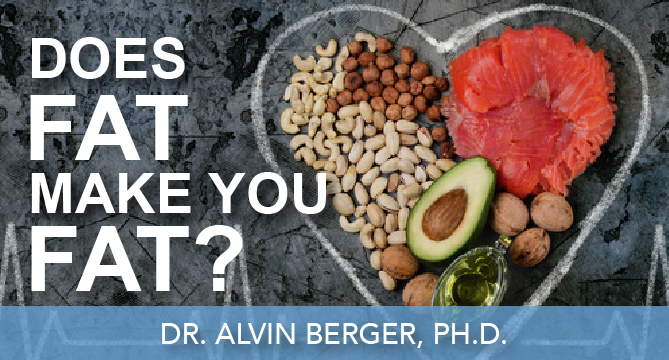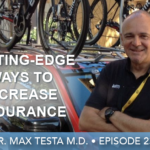Episode 34 | Dr. Alvin Berger, Ph.D. | Does Fat Make You Fat?

CLICK PLAY!
FAMILIAR WITH PODCASTS? LISTEN ON iTUNES!
Follow Along With The Transcript!
Kathy Smith: Alvin, it’s so great to have you on the show. Welcome. I can’t wait to hear about everything you have to tell me. Because, honestly, fat is such an important part of what I think about because I have heart disease in my family. So, this information is near and dear to my heart. Anyway, welcome to the show.
Alvin Berger: Thank you, Kathy. It’s really a great pleasure to speak with you today.
Kathy Smith: Let’s take a little jog or let’s go back down Memory Lane and kind of a timeline of fat. I remember the time in the 70s, for me, where the low-fat craze was everywhere. It was partially due to this idea of heart disease was on the rise, obesity was on the rise, and a researcher a Harvard had come up with a study that recommended a low-fat diet. This, then, became part of our national government guidelines.
And, yet, here we are so many years later and what we saw through the years was that it didn’t make a dent. As a matter of fact, it actually added to the obesity epidemic. So, tell me with all of your research in the last 30 years of research, where do we stand now with fat and its role in our diet?
Alvin Berger: We’ve definitely observed the very unsuccessful experiment in reducing fat, which lead to increased carbohydrates and more obesity. So, we’ve entered a period in time where fats are good again. Fats are healthy, fats are cool. The days of using salad dressings without real oil and all that, I think, are over. For many of us, we’re back to eating in a way that we are not frightened to pour lots of olive oil on our salad. So, I call it the high healthy fat movement, meaning it’s ok to consume lots of fat if you consume the right amount.
Kathy Smith: Two big things that I noticed in that last sentence was right fats, right amount. Let’s talk about that. What are the right fats or the proper fats?
Alvin Berger: Good fats are some of the monounsaturated fats like olive oil and canola oils. In the Omega-3 category, fish oils and also fish itself; cold water species are rich sources of Omega-3s. Medium-chain fatty acids and medium-chain triglycerides, MCTs, that we’ll talk about, sparing amounts of saturated fat.
The days of thinking about saturated fats as toxic are over and we hear about Omega-6 fatty acids in the lay literature as, somehow, being poisonous, toxic and bad. That’s not actually the case, because it all comes down to balance and amounts. Sources of Omega-6 oils are safflower oil, linseed oil, soybean oil are Omega-6 fatty acids.
Kathy Smith: I put my little check list down here so we can go through some of these. Because I think everybody should get a good handle on fats. I know you have your own story about how fat has changed your body through the years, and I have my story about how eating more fat has gotten me into better shape. It’s important to learn about the different types of fats. I can pick mine that I want to start with, but feel free to jump in with where you want to go too.
I would like to start with MCTs. There’s been such an explosion of this talk about MCTs because I would say Dave Asprey and Bulletproof Coffee and this idea that you can take coffee and put butter and put a medium-chain triglyceride in it and what kind of impact that’s going to have on your thinking, on your weight and on your productivity through the course of the day has really gotten us talking about it. I know you have a lot of reasons, many of them personal, why you study MCTs. Could you tell us about it?
Alvin Berger: Yes. Medium-chain triglycerides, let me give you just a little bit of historical text. They were first studied in the 1960s for digestive diseases because they’re very highly absorbed fat. Then, in the 1980s, they were used extensively by body builders to provide energy and increase muscle mass. Beginning in the 1980s, 1990s with the advent of the Atkins Diet and the modified Atkins Diet, we were embracing ketogenic diets. Ketogenic diets, meaning a diet that’s high in fat and low in carbohydrates.
Medium-chain triglycerides became popular in the ketogenic diet. The medium-chain triglycerides are used, now, for weight management. There have been many, many studies showing a reduction in overall weight gain when medium-chain triglycerides are consumed. They’re used for energy sources for everyday people as well as athletes and very, very interesting for cognition as a source of energy for the brain.
At first, it started out that MCTs were used to benefit people with Alzheimer’s, but what’s completely amazing is a study that came out some months ago. They fed medium-chain triglycerides to elderly Japanese men who did not have any Alzheimer’s or even a cognitive impairment, then they looked it up – a range of cognitive tests – and showed improvement with the consumption of MCTs. That’s just, for me, an enormous finding that makes me feel like I’d like to recommend MCTs for anyone as they age.
Kathy Smith: Yeah. I know for me, it makes perfect sense because of how I’ve shifted my diet. And I know that when I have certain days where I’m focusing more on whether it’s writing or work that I have to do that takes more focus, let’s say, that when I have my protein shake in the morning and I’m putting in my protein, my avocado, my MCTs that I notice as I’ve been more consistent with this, that I can sit down, I can get the job done, I can stay focused and I get so much more accomplished. Just firsthand proof. I’ve tested it on people I work with, I’ve tested it on my daughters and everybody sort of gets the same results with it. Do you see it with everybody that you are dealing with that this is a similar result that other people are getting?
Alvin Berger: I do. We produce the KetoMCT product, so I have the pleasure of fielding questions and receiving input from many, many people every single day – people noticing those cognitive benefits. The medium change triglycerides get converted to molecules known as ketone bodies and, then, they readily cross over to the brain and provide an immediate energy source.
Like you were sharing, I call it super multitasking mode. After I have my medium-chain triglycerides, I have two different computers and each of them has two monitors. I race around between these four monitors in a super productive mode after I’ve had the MCTs.
Kathy Smith: I can picture that. Ok. I know exactly what you’re talking about.
Let’s just open up the dialogue about ketogenic diets. There’s so much positive information about them, but there’s still sort of that backlash that happened after Atkins and a lot of things that were coming out that these diets aren’t good for your health and short-term weight loss, yes/long-term weight loss, no. Any thoughts? If you go ketogenic, just to be clear, it’s not just the fat but you have to start cutting back on carbohydrates, and I know there’s a range of 50 grams of carbohydrates, 75 grams, 100 grams. In a really, really strict ketogenic diet, it’s very low with carbohydrates, and I know for a lot of people, they can’t stick to that kind of diet because they miss their carbohydrates. Have we loosened up at all in recent years of how many carbohydrates you can have on a ketogenic diet?
Alvin Berger: Yes, those are great comments, Kathy. The original Atkins diet as well as the so-called modified Atkins diet were very challenging to be on because, as you say, very low carb – about 10% of the calories – and very high fat – 60%. The classical ketogenic diets that were used for epilepsy since the 1920s even are harder to stay on with 90% of the calories as fat.
The cool thing, now, is with the advent of medium-chain triglycerides, which are very readily converted to ketone bodies, it’s not necessary to be on those extremely low-carbohydrate diets. So, 10, 20, 30 grams of carbohydrates is quite ok.
There’s also something known as the mixed dietary regimen, which is what I follow. People like me, we like carbs so the idea of never having a carb again, it’s just too difficult. So, one day I’ll be real low carb. I might be in the realm of, say 20 grams for several days. Then, I’ll say, “You know what? I’m done.” Then, I’ll have carbs the next day. Then, I’ll revert back to the low-carb diet again.
With the classical kind of ketogenic diets, that was very challenging to do that kind of mixed regimen because the body needed to keep adapting to be in the so-called fat-burning mode to generate ketones, but with MCTs, because they’re so potently converted with ketone bonds, it is possible to do this more cyclical kind of diet that I follow.
Kathy Smith: It’s interesting because that’s exactly what I do. Mine is more intuitive or tied into the type of training I’m doing. If I’m going out for a training ride or I’m going to be doing a lot of cardio work, I will have more carbohydrates. If I have a sequence of cardio days, then I know that I’m going to be needing more carbohydrates or my body will handle more carbohydrates.
The opposite’s also true. If I’m going to be sitting, working, I’m might even be on planes, not moving quite as much, I definitely shift more to more protein and higher fat diets. So, I’m kind of switching back and forth and do a mixed diet also.
It’s working really well for me, and I know when it’s time to switch back to less carbohydrates. My body tells me, because it will start to get a little bloaty. I’ll start in my mid-section. It’s just very, very tiny, but you’ll start to notice that I’m just not processing, and I’ll notice in my mid-section.
First and foremost, I’ll notice it in my brain. As soon as I start to feel sluggish, I can’t keep my thoughts on track, that kind of unfocused thinking, I go more ketogenic. So, that’s a nice way to balance it too, and I’m glad you say that, because that’s what I’m doing naturally right now.
Let’s switch back to other fats because MCT’s great, and I know we’ve talked about them. I know I get them in an oil form. I know that you sell them on your site and we’ll get to that later, but in general, where do you get MCTs in food?
Alvin Berger:The natural sources of MCTs are mammalian milks. Goat milk is one of the richest sources, so in my personal life, I don’t drink so much of goat milk, but goat yogurt I love. I actually start my morning, each day, with high-fat goat yogurt, which is rich in C8 and C10, which are potent types of medium-chain triglycerides and, then, I throw into that our KetoMCT oil – one tablespoon. Then I throw another full tablespoon of fish oil right into that.
Kathy Smith: Oh, my gosh.
Alvin Berger: It’s like a really slurry looking thing.
Kathy Smith: I can’t imagine.
Alvin Berger: I mix that up and that’s how I start my day.
Kathy Smith: You would not be that much fun to go out to breakfast with. No. Anyway, yes, I get it. I’m sure with most people, they have the reaction that I just had right now, which is, “Oh, my gosh. That is a lot of fat to have.” So, you’re having that first thing in the morning. Just quickly, what do you follow that up with? When’s your next meal?
Alvin Berger: When you have the right types of fat like the medium-chain triglycerides, they have this effect on satiety. I just want to, if I may say a word of what that word means because it’s very confused. Satiety actually technically means last food at the next meal.
So, when I have that kind of diet that I just described and had that meal at, say, 8:00 a.m., when noon rolls around, I am not ready to eat that much, so I’ll have just kind of a light lunch, which might be sardines in my case – sardines with more olive oil.
Originally, people were very scared of fats when they learned that fats have twice the caloric density, meaning twice as many calories on a gram basis as carbohydrates and protein. So, it seemed logical to people to avoid fats. They said, “Why should I have more of this caloric thing when I’m trying to lose weight?” I still get that question from our customers on a daily basis, but it really comes down to satiety. You can eat a lot of something that’s calorically dense as long as you’re going to eat less at the next meal.
Kathy Smith: Yeah, it makes sense. You’re right. When you eat a high-refined carbohydrate breakfast, you’re hungry right away. That’s what I notice. If you have a snack and you have some crackers, cookies, whatever it might be, you get hungry right away and, yet, you have, in my case–I mean, I might try yours tomorrow–but in my case, I’m mixing those things into a shake base. I have that shake and I’m really not as hungry. I have a similar lunch to what you have.
Today, I cut up cucumbers and small, little tomatoes and I get a little avocado, I get a little salmon and I wrap it up in radicchio. They’re really light and they’re easy to eat and I put some balsamic on it and I love it, but I noticed that I don’t need to eat a lot. It’s enough to keep me satisfied to that next meal.
So, that is a transition that people have to go through because most people are thinking breakfast is like the cereal or whatever and you’re hungry. Then, lunch is the sandwich and you’re hungry and by dinner you’re starving. So, you eat so much more at dinner. The opposite happens when you go on this type of diet. You start out. You have the breakfast, you have lunch and by dinner time, you’re having the right amount but you’re not overeating which is a benefit. That’s how the weight loss occurs.
Let’s switch gears. We got that down. Now, let’s talk about the other fats, because I want to make sure we get in to them. You mentioned your Omega-3s. So, let’s just talk those quickly. That was your sardines and olive oil. What should we know and why are Omega-3s so important?
Alvin Berger: Omega-3s were first studied in Eskimos beginning in the 1960s. What they found is that Eskimos have the highest fat consumption in the world, but they had no heart disease and they did not have psoriasis despite living in such cold climates. So, the whole Omega-3 frenzy started after following those observations that you could consume large amounts of Omega-3s and not have heart disease, not have skin disease.
In recent years, you’ll see when people consume large amounts of Omega-3s, not only heart health and skin health but, also, just general reduction in inflammation, improvement in brain health, cognition and the list has just continued to grow over the years, showing benefits of Omega-3s for so many conditions.
Kathy Smith: So, the Omega-3s, we hear so much about them but, then, we also hear about this ratio of Omega-3 to Omega-6s. Can you tell us a little bit about that? Should we be concerned about that or is that sort of taking care of itself – just if we eat the right foods, we don’t have to worry about the calculation of how many Omega-3s to Omega-6s?
Alvin Berger: Well, I’d like to give a little historical context of things. The ancestral Neolithic ratio of Omega-6 to Omega-3 was actually one to one, meaning people were consuming as much Omega-6 as they were Omega-3.
The ratio in North America of Omega-6 to Omega-3 is one of the most ascrued ratios in the world. It’s somewhere around 15 parts and six for Omega-6 to one part Omega-3. The Omega-6 and the Omega-3, they compete for the same metabolic pathways in the body. So, if you’re consuming a diet that’s very high in Omega-6, even if you, then, made an effort to consume fish in your diet or consumed fish oil, you would not be able to achieve a real benefit – some benefit but not the best benefit. So, that’s why this whole conversation of ratio matters.
Now, your last comment was a particularly interesting one. You kind of reduced it back to a practical perspective and you said, “Let’s not worry so much about these numbers. Can we just get there by eating the right foods?” And I would say the answer is yes. If you have a diet like mine where I’m having fish at lunch, fish in the evening and salads and I’m not consuming large amounts of oils like safflower oil that are rich sources of Omega-6 and I don’t eat a lot of meats, the practical answer is that you can get that right ratio of Omega-6 to Omega-3. I have colleagues that even have managed to get that one-to-one ratio of Omega-6 to Omega-3 just by these practical changes they’ve made to their diet.
Kathy Smith: What would you say as far as a recommendation for people who do eat meat. How many times a week meat? How many times a week fish? I’m assuming you’re putting meat, chicken and pork and everything in that category and, then, you have fish. What would you say? How many times a week would you say would be appropriate to keep this balance in your fat ratio?
Alvin Berger: In my family, we eat meat about once a week. The meat that we get is free of hormones. If I had my way, I’m always on the hunt for hunted meat if you’ll pardon the pun. Because the wild meats are much richer sources of Omega-3s and generally healthy. These are sources like venison, deer that I’m speaking of.
Kathy Smith: Yeah, less hormones and just better sources of fats. Ok. Well, now, let’s talk about heart disease. I think most people that listen to the show who have read anything about my background is I actually got started in the fitness business because I lost my dad when I was 17 years old. He was 42 at the time and he had a heart attack.
So, I have a genetic predisposition for heart disease – my grandfather, a grandmother, a dad and my sister actually died last year from heart disease. So, heart disease is something that has been on my radar for 30 years now, and I get very confused when it comes to fats and especially saturated fats. I’ve really gone to mainly a plant-based diet with fish. As you mentioned, I probably have meat maybe once a month. I eat very little meat.
At the same time, I do know that they’ve changed the guidelines. The government guidelines, now, have cut back on their recommendation. They no longer are recommending that you have to be as restrictive on saturated fats, but I guess the point being, there’s conflicting information out there and it really, depending–and I’m talking about M.D.s, depending on which M.D. you talk to, some will say really restrict saturated fat, some will say you need to go vegan, and others will say it doesn’t have an impact. Where do you stand on the subject?
Alvin Berger: For me, I try to approach my diet in practical ways by eating the foods themselves that give me the right balances like the fish, the avocado, the nuts, more towards the ketogenic way of thinking with respect to heart health as opposed to actually counting out the amount of saturates and so on.
But let me comment a little bit more specifically on the saturated fat. It really started with a researcher called Ancel Keys in the 1970s, and they started looking at the saturated fat intake and coronary heart disease in a number of countries. They observed what’s called a casual relationship between the amount of saturated fat and heart disease.
Casual means you cannot establish a cause and effect relationship. So, they found that as countries started consuming more saturated fat, there was more heart disease. There’s a thing in statistics called covert areas. It means basically the factors that can interfere with the analysis. You can try to account for things like salt intake and other factors in the diet, but it’s very, very hard to do. Those studies from the 70s are, now, being considered flawed by most practitioners including medical doctors because of the many flaws in the study and that it’s not so simple that saturated fats were the culprit.
So, you had saturated fats increasing, but you also had Omega-3 fats decreasing at the same time and Omega-6s increasing. So, you have many people, like you say, still have their own points of view. My perspective on fats for heart disease is maximize the amounts of Omega-3s, maximize the amount of Omega-9s. These are the olive oil, particularly the extra virgin sources, which are very rich in anti-oxidants, keep the saturated fats low but we don’t have to go crazy with that and exercise. Keep your salt consumption low. If you’re going to eat meats, it doesn’t have to be the packaged meats that are full of salt and preservatives.
Kathy Smith: Ok. All good recommendations. Let’s move forward to the future of fat. I know it’s an exciting time for you and that you’ve been developing something called Delta 5 or sciadonic acid type of fat and it’s kind of a breakthrough area. So, can tell the listeners what you’re working on right now and the newest thing in fat consumption?
Alvin Berger: Yeah, it’s really interesting. I have an interest going back many, many years ago in traditional Chinese medicine and fields known as ethnobotany and ethnobiology, essentially trying to understand what people consume around the world different than in the typical western diets.
I came to realize that although not in North America, people eat a lot of oils and seeds from the conifer plants. You might know them in the common names like junipers and pine. I started analyzing these seeds beginning in the late 80s and found that they contained some very unique fatty acids that had these potent anti-inflammatory properties in a number of different model systems we looked at, like lupus, eczema of the skin, skin inflammation, kidney disease, cancer and so on and so on.
I, then, went on to work in an industry for the next 30 years largely focused on Omega-3 and olive oil and some of the other facts we’ve been discussing today. But I could never quite get it out of my system that I was aware of these very potent and interesting facts.
The challenge was really how do you make a commercial business out of this, because you have to have a source of these special conifer oils that makes economic sense. So, I spent 20 years working on the sourcing, and when I figured out the sourcing, meaning that it’s abundant, safe and not too expensive, I started the company Kathy just mentioned, Sciadonics. It’s just really exciting right now and we’re just getting going. We’re focused, for right now, on the skin because we’ve observed very interesting benefits to the skin in animal models and we’re starting to see those same benefits in humans.
Kathy Smith: So, do you have a product right now or is it being developed?
Alvin Berger: The product is being developed. We’re still about one or two months away from launching.
Kathy Smith: Ok, and it’s called Delta 5?
Alvin Berger: Yes, the marketing people have really despised this word, sciadonic. [overlapping speech 00:31:45]
Kathy Smith: I can see why because even when I said it, I mispronounced it. I said si-a-don-ik, which now I know, it’s ski-a-don-ik. Of course, it is.
Anyway, we look forward to hearing – using. I look forward to using it. Anything to do with skin and anything that’s anti-aging and helping you to look younger is something that I think we’re all interested in. I know that as far as fats that you use on your skin, on your body, be it oils or fats or creams as well as what you ingest, it all works in a way to increase your health span so to speak. So, how to live longer, those healthy years.
That’s why I love what’s going on with your science, your research right now into fats and I think it’s cutting edge. It’s going to be the next wave of what people will be doing, so I appreciate you sharing your story, and I look forward to having you back and talking more about where we can get it.
But for right now, I know that if you want to know anything else about fat, you have to go to Dr. Berger’s website, ketomct.com or find him on Facebook. If you’ve enjoyed the show today and you want more practical tools, meal plans, recipes and products, definitely check out his site.
Also, for anybody who’s got diabetes, whether it’s Type I, Type II or pre-diabetes, you should also go to Dr. Berger’s site because that’s another area he’s passionate about and understanding the link between fat and how it impacts your blood sugar levels.
So, lastly, if you’ve come here because you’re interested in living a vibrant, healthy life, you might want to check out some of our other episodes. I sure hope so! Like the one I did with Dr. Oz, which reveals the single most underappreciated problem in America or the episode with Diana Nyad where she shared what it’s like to push past your limits and how she did that while she was swimming from Cuba to Florida and recently with Dr. Sara Gottfried who shared her experience of how to reset your genes, how to reverse aging and turn back that clock. All sort of interesting things you might be interested in.
So, Alvin, thank you so much as friend, as a doctor, as a person who I have respected and admire. You are such a Rockstar, and I appreciate you coming on the show.
Alvin Berger: Thank you, Kathy. It’s really been an honor to participate today.
Kathy Smith: Ok, thanks so much. Talk soon.









